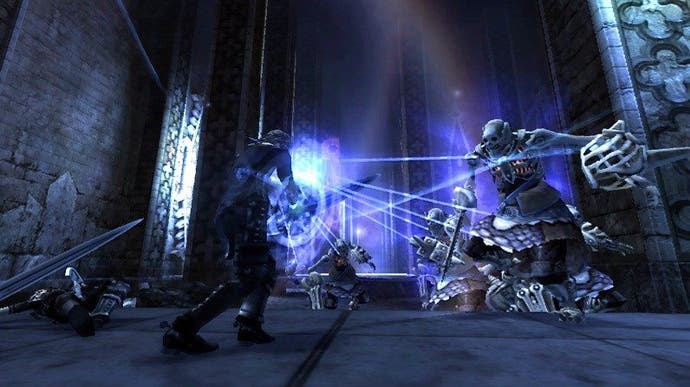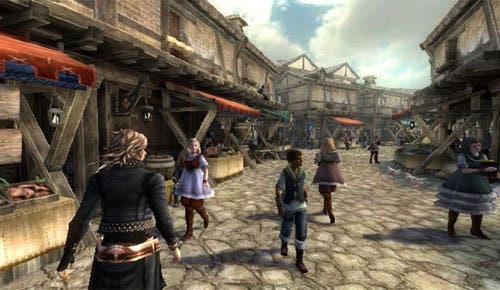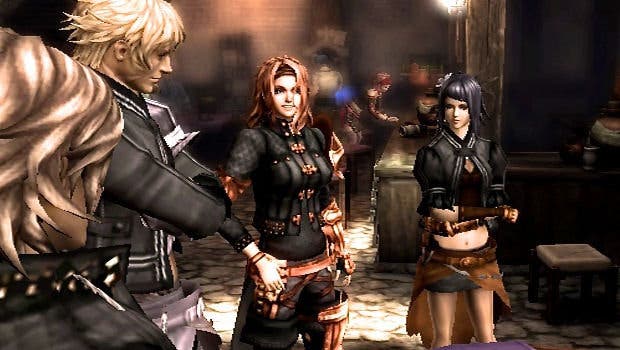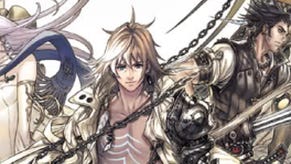The Last Story Review
Tale spin.
Hironobu Sakaguchi helped invent the modern-day Japanese role-playing epic. In 1987, having skirted around the edges of games development at the then-fledgling outfit Square, he decided to give it one last shot before moving on. That project's title has been the basis for one of gaming's most enduring and entertaining contradictions.
25 years on from the first Final Fantasy, Sakaguchi has moved on. Following the release of The Spirits Within, Square's multi-million-dollar CGI folly that remains one of cinema's greatest disasters, Sakaguchi founded Mistwalker: co-creators of traditional fare such as Blue Dragon and Lost Odyssey, games cut from the same cloth that Sakaguchi first wove.
Looking back, you'd be forgiven for thinking that the genre's hardly moved on at all. There's a strong, clear line that can be drawn from the first Final Fantasy to the likes of Lost Odyssey, their rich worlds held together with turn-based combat and a pairing of heavy exposition and free-form exploration.
The Last Story - Mistwalker's latest, and Sakaguchi's first game as director since Final Fantasy 5 - is an attempt to reinvent the modern-day JRPG epic. Its tale is told in under 20 hours, its action is fast, in real time and requires no grinding, while its systems are slick, streamlined and easy to grasp. It's an RPG like no other before it.

Its desire to tear things up isn't explicit at the outset. Set in and around the fantasy setting of Lazulis Island, The Last Story is framed by the ongoing war between humans and the Gurak, and its story is as well-worn as it is simple: boy meets girl, gains superpowers and proceeds to save the world. Just another day's work for your typical JRPG hero.
But while its backdrop and tale are plucked from the dog-eared JRPG textbook, they come alive in the telling. The Last Story is a beautiful game, its visuals washed through with a sepia tone that perfectly reflects the wistful melancholy that Sakaguchi's work has been steeped in; a thick, deep sunlight lends the world a soft autumnal glow.
Lazulis City, the sprawling hub from which The Last Story's various chapters spring forth, is a breathtaking construction. It's the heart of the game, coursed with sinewy alleyways where you can chase the echo of people lost in lazy mid-afternoon gossip to find secluded courtyards that then give way to bustling markets and picturesque waterways. It's one of games' great cities, and it's a heady pleasure to get lost in.
Its characters benefit from an equal amount of care and colour as well as some thoughtful translation. The lead - the softly spoken orphan, Zael - is sadly limp, though the group of mercenaries that he surrounds himself with are anything but. They're a likeable and memorable bunch, thanks in no small part to another incredible localisation job from Nintendo.
There's Syrenne, the bawdy, heavy-drinking vixen with a blunt yet strangely fitting Lancashire accent, and her partner in crime, Lowell, equipped with an equally apt soft Scottish burr. Such strong regional accents shouldn't sit so well in a JRPG, but with The Last Story's world being made out of thick oak, worn stonework and black lace, they work well with the European flavour suggested by the art design.

Together, they inspire a sense of camaraderie that's often invoked in RPGs, but rarely so successfully. Indeed, it's the bond between the group rather than the telegraphed story beats that fuels the impetus for progression, and The Last Story's swathes of downtime as you chat with team-mates often provide the game's brightest moments.
With such strength of character and warmth in its aesthetic, it's disappointing that, in Mistwalker's eagerness to jettison many JRPG tropes, it's thrown away so much that makes the genre compelling. Its systems are streamlined to the point where you can feel like a hindrance to the game's desire to tell its tale.
The combat is a daring hybrid that never quite takes off, an odd mesh of mechanics that rub up uncomfortably against each other. For the first few hours, it's simple to the point of being confusing, skirmishes being won with scant input or insight into the system's depths. Fights are prefaced with an overview of the battlefield, giving you the lay of the land and a little tactical foresight - and once the fight starts proper, the action's in real-time.
As Zael, you can snap to cover before firing off an assortment of ammo types from your crossbow (including, amusingly, banana skins that can send enemies crashing to the floor), pause the action to direct your comrades, or get up close and personal for a melee attack. With large groups of enemies often thrown into the mix, it tends to descend into a messy bundle, and at this point you're encouraged to engage Zael's gathering ability - a power that attracts all nearby enemies and allows you to shepherd the action.
The fighting is quick-footed and dynamic, and it's stretched out across an impressive range of situations. Stealth sections in which Zael can spring from cover to deal a deathly blow give way to extended scenes of crowd control as you acrobatically dance from victim to victim, while boss encounters introduce additional layers of strategy.

But it never involves you anywhere near enough. By default, melee attacks are carried out automatically, and even when everything's under your control, fights are typically won with numbing ease. There's rarely the need to dip into the five lives that you're granted at the beginning of each encounter.
Character progression is also puddle-deep, with levelling being taken largely out of your hands. Outside the ability to equip your party, there's the chance to tailor each character's appearance to a stupendous degree, with dyes and pigments allowing you to become an alchemist of colour. It's scant compensation for having little meaningful control over your party's proficiencies.
Comparisons will inevitably be made to Monolith Soft's Xenoblade Chronicles, a JRPG defined by its sense of freedom and its generosity. The Last Story is filled with a similar spirit of innovation, though where it ends up is nothing like as satisfying. Its world is beautiful, but the few opportunities for exploration rob it of the thrill of its more expansive counterpart, while its battle system excites but never truly engages.
The Last Story is born from the same desire to reinvent the genre that both Final Fantasy 13 and Xenoblade Chronicles sprung from, but in sacrificing complexity to serve narrative, it seems that Sakaguchi has arrived at the same place as his former employers. It's a familiar mix of wonder and frustration, and it's eclipsed by Monolith's more intoxicating vision of the JRPG's future. The end result is a tale that's worth hearing out, but hard to hold dear.

















